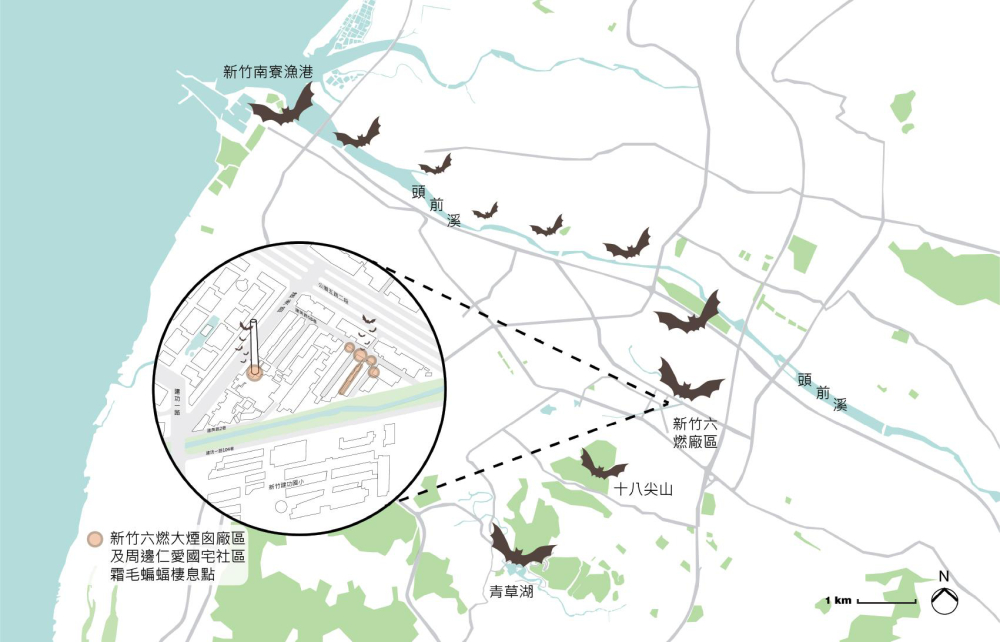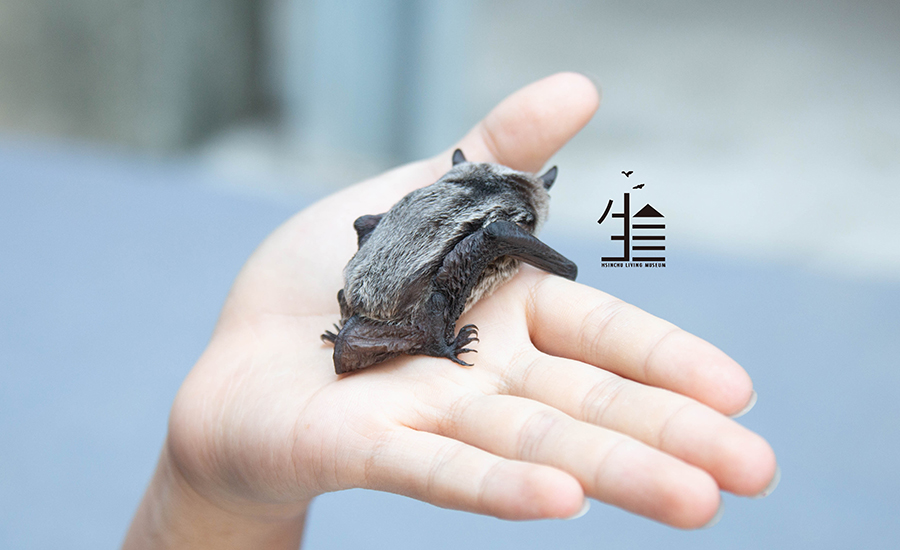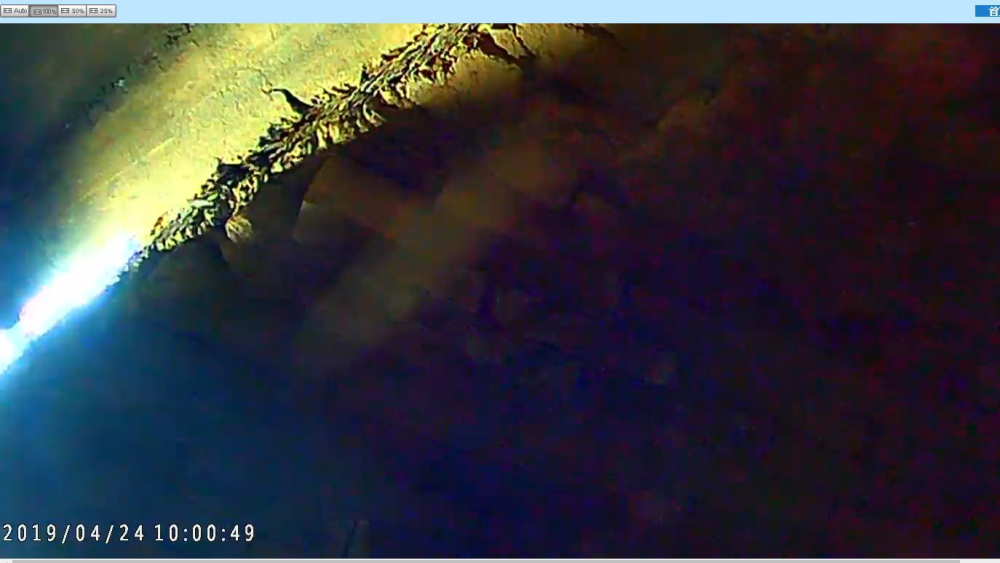《霜毛蝠生態監測與研究系統》與《蝙蝠生態教育空間》
《Asian Parti-colored Bat ecological monitoring and research system》&《Asian Parti-colored Bat Ecological Education Space》
陽明交大保溫睦鄰駐站團隊 NYCU Team of Good Neighborliness Residency
2010年珍貴霜毛蝠的發現讓原日本海軍第六燃料廠新竹支廠不但是具文化價值的歷史遺構,同時也成為生態保育中國家瀕危動物的重要棲地。霜毛蝠在六燃廠區的棲息範圍主要在大煙囪內部和附近民宅鐵皮屋頂夾層內,於每年4月到9月期間遷徙至大煙囪和周邊民宅鐵皮屋內產子育幼。基於保育與生態教育價值的考量,在台灣蝙蝠學會、行政院農業委員會特有生物研究保育中心與中原大學城鄉規劃與設計中心提供專業的諮詢與協助下,交通大學保溫睦鄰駐站團隊及資訊學院以先進的智慧物聯網技術結合即時視訊監控與IoTtalk平台,共同設計並建置一套兼具研究與教學功能的智慧監控系統,用來長期觀察、記錄大煙囪內霜毛蝠的生態變化。
同時,交大六燃團隊透過執行新竹市文化局的「大煙囪廠房基地」保溫睦鄰駐站計劃,在大煙囪旁的建美路38號建置「霜毛蝠生態教育空間」,不但有駐站藝術家和工作人員在此舉辦活動,與新竹市民互動對話,也出版、展示關於霜毛蝙蝠相關資料與研究論文,讓民眾能參與此處的藝術、生態保育、智慧科技等教育活動,如蝙蝠生態監測影像觀察、蝙蝠救傷生態工作坊、藝術參與社區等活動,以進一步瞭解關於霜毛蝙蝠的多重樣態,包括棲地、賞蝠規劃、棲地空間營造、霜毛蝠的活動遷移、生態習性、可愛的面貌、特徵,與目前所面臨的種種危機。
The discovery of the precious Asian Parti-colored Bat (Vespertilio sinensis) in 2010 made the former Imperial Japanese Navy’s Sixth Fuel Factory, Hsinchu Branch not only a historical site with cultural value but also an important habitat for ecological conservation. From April to September each year, the Asian Parti-colored Bats tend to inhabit inside the fuel factory’s big chimney and between the layers under the sheet metal rooftop of the nearby buildings. Pregnant female bats fly to Hsinchu around April and deliver their babies in the aforementioned places.
For the purposes of ecological conservation, research and education, and supported by the Bat
Association of Taiwan and the Endemic Species Research Institute, Council of Agriculture, the Institute of Applied Arts and the College of Computer Science designed a monitoring system by integrating real-time video surveillance and the IoTtalk platform, and then installed it inside the big chimney for long-term ecological observation and research.
Additionally, the Asian Parti-colored Bat Ecological Education Space is established for the public at the location of No. 38, Jianmei Rd., Hsinchu City. Citizens are thus able to better understand this species by partaking in the educational activities of science, art and technology held at the education space. Both the monitoring system and the education space can serve the functions of ecological conservation, research and education.
大煙囪的好鄰居「霜毛蝠」
Asian Parti-colored Bat, the good neighbor to the big chimney
文 / 台灣蝙蝠學會 周政翰 秘書長

圖 / 邱筠穎
2010 年 7 月在新竹六燃大煙囪發現約 700 隻群集的保育類霜毛蝠。每年霜毛蝠母蝠在冬眠甦醒後,自遙遠的度冬場所 3-4 月間陸續飛抵大煙囪產子育幼。待幼蝠長大,於 8-9 月間陸續飛離大煙囪廠區。在新竹大煙囪內發現霜毛蝠,是台灣生態保育界的一則大新聞,該分布至溫帶高緯度國家的物種,於台灣的發現為現今該物種分布的南界,而至於為何偏好於新竹六燃煙囪及周邊生產育迄今仍是個謎。
新竹六燃大煙囪廠房和周邊眷戶,是戰爭移民,而煙囪的圓柱結構內則另外住了一群神秘的「遷移者」,不是因為戰爭,而是因為溫暖的新竹在地氣候來到這裡,和眷村居民共處了五、六十年。起初,這些蝙蝠是什麼物種?哪裡來?沒有人知道,長年來也沒人問過,一直到 2010 年,透過台灣蝙蝠專家的確認,牠們的身分才真正揭曉,叫做「霜毛蝠」。
In July 2010, a group of around 700 Asian Parti-colored Bats (Vespertilio sinensis, a protected species) were discovered in the big chimney of the former Imperial Japanese Navy’s Sixth Fuel Factory, Hsinchu Branch. Spending the winter months in hibernation, the pregnant female bats tend to fly a long way from remote places to the big chimney between March and April every year for delivery, while the newborn bats leave the big chimney between August and September every year after they grow to maturity. The serendipitous discovery of Asian Parti-colored Bats in Hsinchu was sensational for the ecological conservation circle in Taiwan. This species’ main habitats are in the temperate zone of Northeast Asia. The discovery of Asian Parti-colored Bats in Taiwan is the southernmost record of this species’ existence on the earth. However, the reason why the pregnant female bats prefer Hsinchu for delivery remains an intriguing mystery.
霜毛蝠的棲息現況
The Habitat of Asian Parti-colored Bats in Hsinchu
霜毛蝠是這裡的生態住民,在曾經於二戰時期生產戰爭工業燃料的大煙囪廠房區繁衍後代、延續生命。據台灣蝙蝠學會 2011 至 2018 年的調查發現,霜毛蝠主要群集從原本的煙囪棲所分散至周邊仁愛國宅社區屋頂鐵皮夾縫中。六燃團隊和台灣蝙蝠學會於 2019 年年初,修補大煙囪的縫隙與架設蝙蝠屋,這些都是為了讓霜毛蝠能每年回到煙囪棲地所採取的保育手段。八月團隊成員觀察到有蝙蝠從架設的蝙蝠屋飛出,之後經蝙蝠專家確認是霜毛蝠移入居住。霜毛蝠的保育工作到目前有很好的結果。霜毛蝠與新竹六燃共生共存,是這裡的一份子,已成為大煙囪歷史的活傳奇。
The bats are the ecological residents in this area. They come to the big chimney factory, a facility used to produce fighter plane fuel during the Second World War, for reproduction, in order to ensure the survival of their species. According to the investigation by the Bat Association of Taiwan from 2011 to 2018, the main aggregate of Asian Parti-colored Bats has expanded from the big chimney to the chinks underneath the corrugated-metal roofs of the Renai Public Housing.In early 2019, the team of NCTU, CYCU, and Bat Association of Taiwan not only sealed the cracks on the cylindrical big chimney, but also completed a preliminary hang of bat boxes, expecting Asian Parti-colored Bats to come back here so that the work of species conservation can continue. This August, the NCTU team saw some bats emerging from the bat boxes, and Taiwanese bat experts confirmed that these boxes have been occupied by Asian Parti-colored Bats. This encouraging result implies a good conservation status of this species. They’ve established a symbiotic relationship with the former Imperial Japanese Navy’s Sixth Fuel Factory. Being part of this place, these bats have become a living legend of the history of the big chimney.
觀察與保護霜毛蝠的方法
Approaches to Observing & Protecting Asian Parti-colored Bats
生態觀光:賞蝠規劃(每年4月到9月之間)
Ecological observation: bats appreciation planning (annually between April and September)
- 利用保溫計畫架設之蝙蝠監控系統即時影像直播,可觀測霜毛蝠在新竹六燃大煙囪內的棲息狀況。
- 於夏季傍晚6至7點蝙蝠外出覓食時段,可至新竹六燃大煙囪周邊(圖示之社區觀察點),以裸眼觀察民宅頂樓鐵皮屋頂夾縫。
- Drawing on the real-time images provided by the monitoring system under the Good Neighborliness Residency Project, visitors are allowed to observe the bats’activities in the big chimney of the former Imperial Japanese Navy’s Sixth Fuel Factory, Hsinchu Branch.
- During 6 and 7 p.m. in the summer evenings when the bats emerge, visitors can observe with the naked eye the bats’ activities in the chinks underneath the corrugated-metal roofs of the private houses in the Renai Community near the former Imperial Japanese Navy’s Sixth Fuel Factory, Hsinchu Branch.
營造霜毛蝠良好的生存環境
Creating a Hospitable Environment for Asian Parti-colored Bats
- 大煙囪為蝙蝠遷徙返回新竹的辨識地標,建議管控未來周遭建物發展的高度。
- 製造有利於蝙蝠躲藏,不易受人為及貓、喜鵲等天敵干擾的棲地空間。
- 創造綠帶生態走廊連結棲地與覓食地點。
- 避免蝙蝠飛行路徑上的光害。
- The big chimney is a crucial landmark of reference for the bats’ navigation in their way back to Hsinchu. We suggest that the height of nearby buildings shall be subject to government regulation and control.
- Providing the bats with supportive roosts where they can avoid efects from human disturbance and their predators such as cats and magpies.
- Creating “green belts” (ecological corridors) that link the bats’ habitat with their feeding sites.
- Eliminating the light pollution in the line of fight of the bats.

